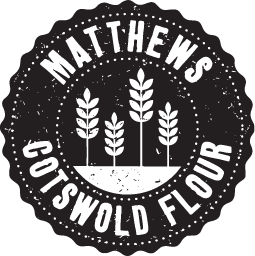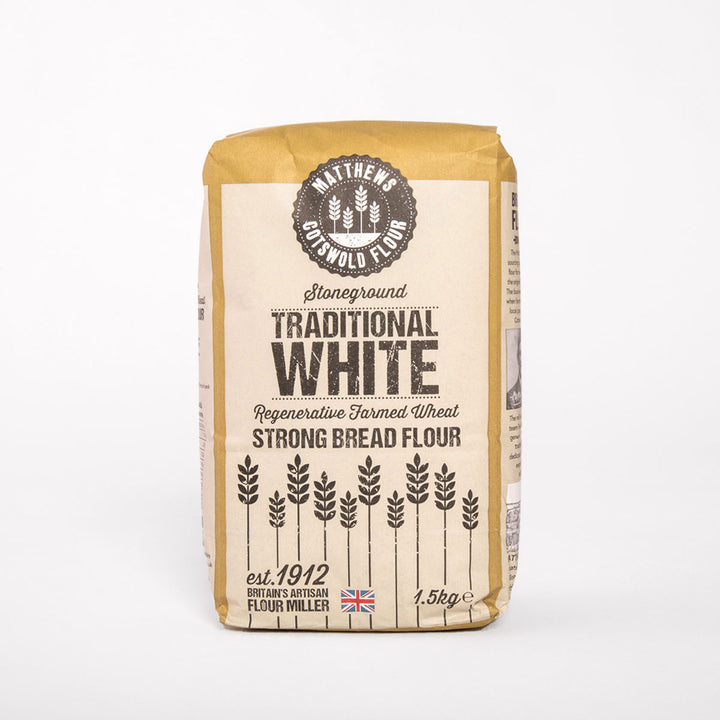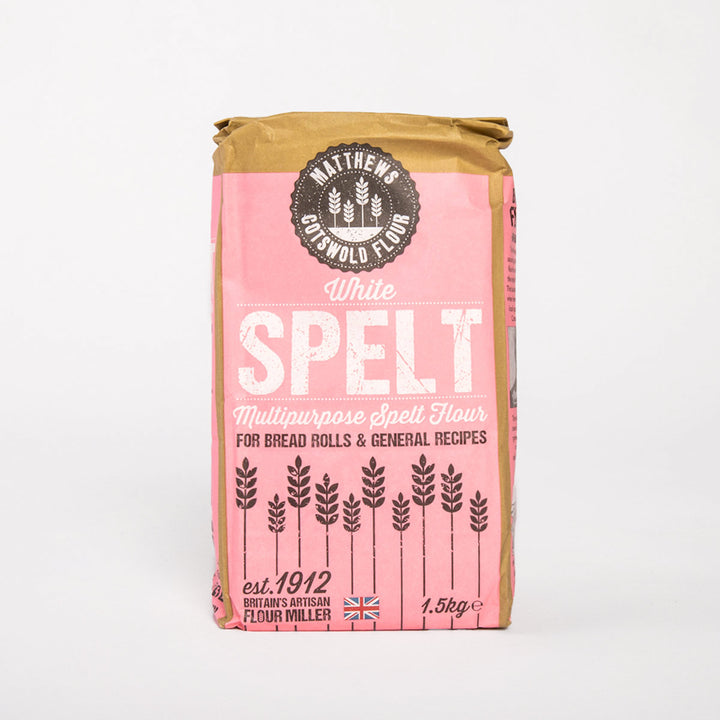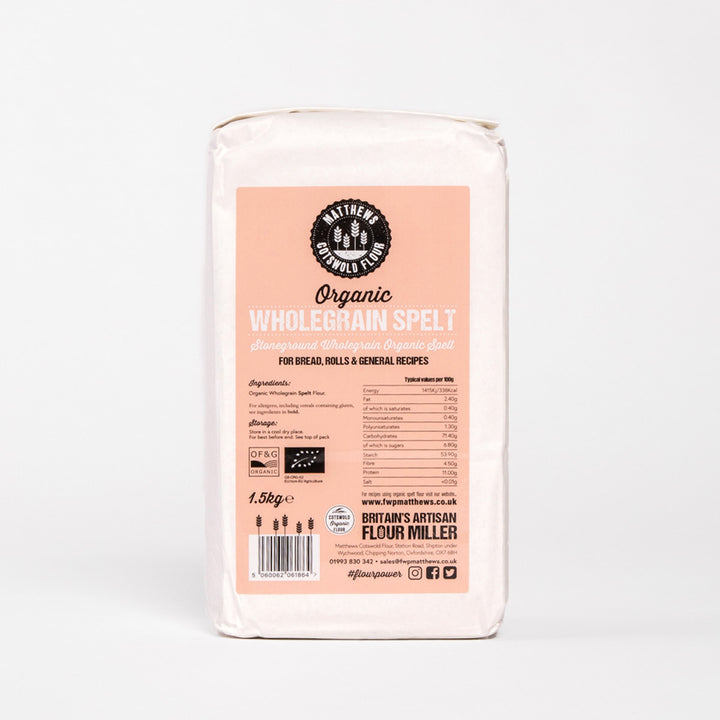What is Regenerative Agriculture?
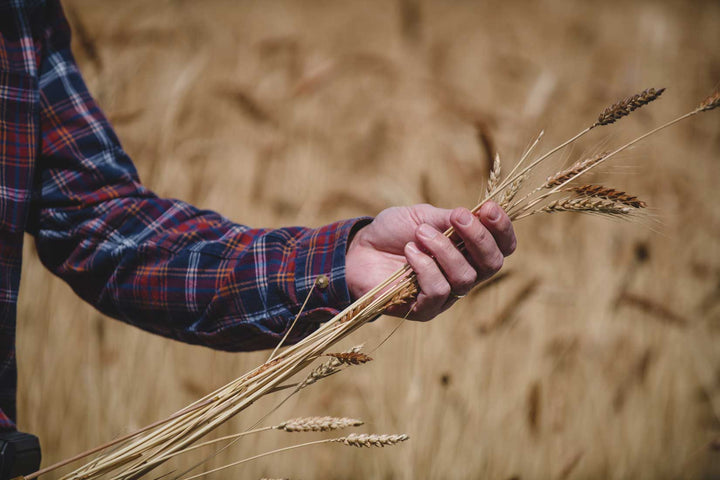
By Bertie Matthews | Managing Director | Matthews Cotswold Flour
Regenerative farming, regenerative agriculture or “Regen Ag” is a term that is at the centre of farming today. Although there is no official definition, its practices are about growing food in a way that improves soil health and the wider environment. It’s not just something farmers need to know, but also bakers, consumers and millers alike, and we all have a big part to play. Over the last four years, I have tried to advance my own knowledge by talking to some of the pioneers regarding this new way of thinking about how our food is produced. The elements of the system are not actually new, they’re ancient, in the sense that they rely heavily on nature to make the right decisions as has always been the case.

Bertie Matthews with father, Paul Matthews, on a farm walk at FarmED in July 2022.
“My father, Paul, became deeply passionate about organic farming in the late ‘80s. We often talk about the future of the mill and the farms that surround us. We both see regenerative agriculture as the next natural step for future generations... but what exactly is it?”
What is Regenerative Agriculture?
Regenerative agriculture or “Regen Ag” is a term that refers to a model of growing food that improves biodiversity and soil organic matter. At its centre are several core principles focusing on improving soil fertility, biodiversity, water retention and cleanliness, minimising soil disturbance and enhancing nutrient cycling. Members of the Cotswold Grain Partnership consider its principles to be the future of our farming food system. Our mission is to maximise the acreage coming from sustainable farming sources. Some have also included a model that adapts to local environments, includes a fair-trade pricing system and develops opportunities for new jobs and skills. From what I have read and heard so far, these last elements are just as important for a truly sustainable food future.
Why is regenerative farming important?

For the past 70 years and arguably more, our food system has been all about feeding everyone on the planet. The mission has been improving the yield of crops like wheat by using chemicals, “monocropping” and reducing the price of food. This last element, sometimes referred to as “the race to the bottom”, has hidden damaging long-term effects. What we have won in yield, we have lost in soil health and nutrition. Degrading soil health will reduce our ability to produce the food we eat in the long run. Degrading nutrition in our food has led to malnutrition, even in those who are overweight and obese. As world problems go, the degradation of soil health is the big one.
If the soil is degraded, it can’t hold water. This leads to erosion of soil organic matter and is more prone to draughts as well as producing poor crops. In simple terms, the true source of our food is reliant on these six inches of soil.
Traditionally, it has been hard for farmers to make enough money to reinvest in their farms, let alone make a living. The conventional farming system is dependent on chemicals that maintain yield to produce food. The organic farming system has a much lower yield but much higher price tag. With the current farming system, we could be creating an even greater cost of living crisis for the future of our children and grandchildren.
Our farming practices, both conventional and to a lesser extent organic, have been in part destroying our soils and wider biodiversity. Regenerative agriculture is a way to reverse this damage and have a positive impact on the land and its future potential to produce nutritious food.
Sustainability or sustaining the current situation is not enough. Moving forward and regenerating our soils through regenerative agriculture is pivotal.

What are the regenerative farming principles?
There are five main regenerative farming principles but also some other elements that are just as important. The objective of these principles is to strengthen the health and vitality of our farms’ topsoil. There is no definitive list but rather guidelines and/or tendencies. We use this list as a guide when speaking to farmers to assess the actions for change being implemented.

1. Reduce Soil Disturbance:
Minimising chemical and physical soil disturbance. Dragging a big plough through a field releases carbon into the atmosphere and destroys living roots.

2. Crop Diversity:
Growing a diverse range of plants to encourage biodiversity and increasing plant and microbial diversity.

3. Integrate Animals:
Integrating “mob grazing” livestock into the system to help develop organic matter.

4. Maintain Living Roots:
Keeping the roots of plants intact which is vital for feeding organisms in the soil. Achieve through no or minimal till process.

5. Protect Soil Surface:
Using “Cover Crops” increases water penetration into the soil by opening tiny channels, contribute to producing organic matter by feeding the grazing livestock.
One must be mindful that every country, county, valley, land and soil are different; so the system should be flexible and adaptable for this.
Other elements include carbon sequestration “Carbon Capture”, cleaner air, enhancing wildlife, fair trade, developing job opportunities and skills for new farmers and food producers.

Does Regenerative Agriculture have to be Organic?
This is up for debate, but simply, no, it doesn’t. Organic is already a certification whereas regenerative agriculture is not yet. Certified organic farms that can apply all these principles, while regenerating soil fertility is preferable. There is a lot of overlap in the methods and for many areas around the world this may be too much of a step. After 30+ years, organic land represents less than 3% of all land farmed in the UK. For farms to be truly “sustainable” they must be financially sustainable. A system must work for the small tenant farmer as well as a large landowner.
Having to comply 100% to organic certification bodies would A: Make the food more expensive as we have seen (look in the supermarket) B: Reduce the long-term yield on average limiting our ability to produce enough food (based on national averages) C: Reduce our ability to adapt to local environments. Some farms will be able to implement a 100% no till, direct drilling, incorporating livestock etc. But others may not have that luxury due to their location and soil type. The positive thing with regenerative is that it is adaptable to local environments which is essential for scalable change to soil health.
Problems with the term?
- Confusion: What Regen Ag is and what it isn’t is up for interpretation, which means confusion reigns. There is not yet a universal accreditation to nail down on its principles but a common drive to improve soil fertility and biodiversity.
- There is no one size fits all: Above I have listed five core principles however there are many other aspects. Some organisations list seven or a completely different list but there are still some common themes around soil fertility, biodiversity and reducing soil disturbance.
- Education: Consumers, bakers and farmers’ development of their understanding of the principles.
- Economic: Moving from one system to another is not always financially viable for farmers. Your whole farming system may be reliant on a conventional chemical-based system. This is great for short term yield but poor for long-term fertility. If farmers want to maintain fertility and yield in the future a long-term view not reliant on chemical inputs is essential. Businesses further up the supply chain, millers, food producers, bakers etc. need to provide a market and financial incentive to farmers to make the long-term change. We can have affordable nutritious food with regenerative agriculture.
What role do flour millers have to play with “RegenAg”?
In the UK each day we eat 12 million loaves of bread, 2 million pizzas and 10 million cakes. More households in the UK buy bread than any other food product! The food producers and millers like us in the UK and wider world have a big part to play. Three keyways as an industry we can help are:
- Collaboration: Food producers in the UK come to a consensus that conventional industrial farming must be phased out over time. We need to move towards a system that produces safe, affordable and nutritious food that doesn’t destroy our soils. Flour millers in the UK mill approximately 6.2 million tonnes of wheat in the UK every year. There is over 4 million acres of land used for milling wheat alone. Even a small percent of that would make a monumental impact on the soil health and biodiversity.
- Build into strategy: Moving to sourcing grain from regenerative sources should be part of every food manufacturer's strategy. We all want to use British wheat in 50 years’ time so let’s start incentivising farmers to look after our soils to enable this. Work with brands that put regenerative agriculture at its centre. This strategy is a team effort.
- Education & Understanding: As a flour miller, member of a farming partnership, food producer and/or consumer, we all need to upgrade our knowledge. Take advantage of easily accessible online resources and/or physically visit non-profit organisations such as Real FarmEd up the hill from us to learn more.

Quick and easy way to explore more, follow some farming rockstars. Here are some that I consider myself a fan boy to:
- Ben Thomas: Treveddoe Farm Cornwall > @ben_thomas7_
- Niels Corfield: Farm Advisor > @niels_corfield
- Ben Adams Farmer and consultant – Oxfordshire @benadamsagri
- Ed Horton: Farmer and Ergonomist Poulton Farms > @e.a.horton
- Richard Perkins: Farmer and Author Sweden > @richardperkins.co
- Nicole Masters: Agroecologist and Author “For the Love of Soil”> @ masters.nicole
Where can I buy Regen Flour?
You can now buy Regen Flour direct from Matthews Cotswold Flour. We currently have a number of Regen Flours available including Matthews Regenerative All-Purpose White and Matthews Regenerative Stoneground White. We have a wide range of Regen flours for professional bakers including: Regenerative Artisan Strong Bread Flour, Regenerative Fine White Pizza Flour, Regenerative Plain Flour, Regenerative Self Raising Flour, Stoneground Regenerative Wholegrain and Regenerative White and Wholegrain Spelt.
What next for Regenerative Agriculture?
Following on from the great work already carried out by smaller brands, over the next ten years it’s the big companies that must take the step forward to make a real change. It is a team effort, farmers, grain merchants, millers, bakers, and food producers all have a significant role to play.
There are already some fantastic brands trailblazing a future for regenerative agriculture. Our friends at Wildfarmed have been working with farmers and bakers across the country over the last few years. They have done a fantastic job in promoting this new system. It has been a true pleasure to create their Wildfarmed flour for them at Matthews and mill their grain through the stones. We wish them the best of luck for the future. Check them out here.
Lune & Wild who are re-thinking baby food with seasonal meals derived from regenerative agriculture. Their mission is to help parents raise curious and confident eaters whilst protecting our planet for the next generation.
Trewithen Dairy in Cornwall are working with farmers who are incorporating regenerative farming techniques in the commercial production of milk.
“What is so good, two-and-a-half years into the project, is actually seeing a milking herd out grazing a herbal ley – and they’re clearly enjoying that pasture among flowers and herbs, which are supporting biodiversity at the same time.” Francis Clarke, Managing Director
Earlier this year, Matthews helped support an awesome new film; Six Inches of Soil. The inspiring story of British farmers standing up against the industrial food system and transforming the way they produce food - to heal the soil, benefit our health and provide for local communities.
There is no better way to learn more than going to visit a farm.
Just up the hill from the mill is “FarmED” a new centre for farming and food education, focusing on the crucial link between good food and good farming. Founded by the brilliant Ian Wilkinson and based at Honeydale Farm. They run workshops, events and farm walks on Fridays. If you are ever in our area I highly recommend going for a visit.

We asked Ian why Regen Ag is important today.
“The ‘green revolution’ of the 20th century fed a growing global population at a time of need. It sought and delivered efficiency and safe, affordable food for many. But the food system that emerged was, and remains, inherently depletive - extracting value from our soils, habitats, and landscapes. It is clear that the original concepts of preservation, conservation and sustainability, protecting what we currently have, are no longer enough. We must do something radically different. we must think and move to a space beyond sustainability. We must move at pace to a position of regeneration – rebuilding, enhancing, and improving. That’s where regenerative agriculture comes into play. ”
Finally, Groundswell, The Regenerative Agriculture Show and Conference. What Glastonbury is to music, Groundswell is to regenerative agriculture. The Groundswell event provides a forum for farmers, and anyone interested in food production or the environment to learn about the theory and practical applications of Conservation Agriculture or regenerative systems, including no-till, cover crops and re-introducing livestock into the arable rotation, with a view to improving soil health. Highly recommend going for a day or two in June.
I truly believe there has never been a better time to be a farmer, miller, baker, and/or food producer. I hope you have found the information interesting, and you enjoy taking your regenerative experience further.
Bertie Matthews.
5 years in the making - we are excited to launch our first Regeneratively Farmed Flour:
← Older Post Newer Post →
